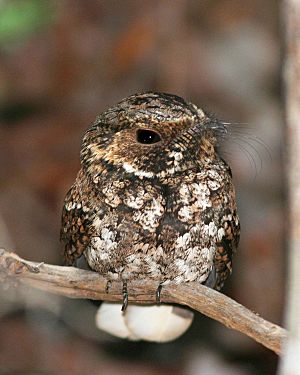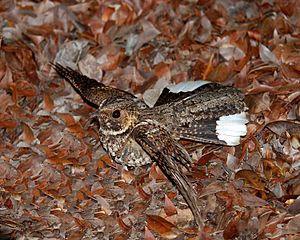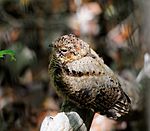Puerto Rican nightjar facts for kids
Quick facts for kids Puerto Rican nightjar |
|
|---|---|
 |
|
| Conservation status | |
| Scientific classification | |
| Genus: |
Antrostomus
|
| Species: |
noctitherus
|
| Synonyms | |
|
Caprimulgus noctitherus (Wetmore, 1919) |
|
The Puerto Rican nightjar (Antrostomus noctitherus), also known as the Puerto Rican Whip-poor-will, is a special bird found only in Puerto Rico. It lives in the dry scrub forests along the coast in the southwestern part of the island.
This bird was first identified from bones found in a cave in 1916, and from a single bird skin from 1888. People thought it was extinct for a long time! But then, in 1961, living birds were finally seen in the wild. Today, there are about 1,400 to 2,000 adult Puerto Rican nightjars. This bird is currently listed as an Endangered species because it is losing its home.
Contents
What Does It Look Like?
Puerto Rican nightjars are small birds, about 22–23 centimeters (9 inches) long. They weigh around 39-41 grams (about 1.4 ounces). Their song sounds like a quick "whip" sound.
These birds have feathers that are a mix of black, brown, and gray. This mottled pattern helps them blend in perfectly with their surroundings, like tree bark or the ground. This is called camouflage.
- Male birds have a black throat with a thin white line across it.
- They also have white spots on the lower part of their tail that you can see when they fly.
- Female birds have a buff (light brownish-yellow) color instead of white.
Puerto Rican nightjars have large, dark black eyes and a short gray beak. Like other nightjars, they have stiff bristles around their beak. These bristles help them catch insects while flying!
A Story of Discovery
The Puerto Rican nightjar was first found as a single bird skin in 1888. Later, in 1916, bones of the bird were found in a cave in northern Puerto Rico. At that time, scientists thought the bird was already extinct.
It wasn't until 1961 that living Puerto Rican nightjars were finally seen! This happened in the Guánica Dry Forest. Detailed studies of these birds began in 1969, helping us learn more about them.
Where Do They Live?
In the past, the Puerto Rican nightjar probably lived in more places, including moist forests. Today, it mostly lives in dry forests. These forests often have lots of fallen leaves on the ground and open spaces under the trees.
You can find these birds in three main areas in the southwest of Puerto Rico:
- Susúa State Forest
- Guánica Dry Forest
- Guayanilla Hills
In 2005, a Puerto Rican nightjar nest was found for the first time in Maricao State Forest.
Life and Habits
The Puerto Rican nightjar eats beetles, moths, and other insects. It catches these insects while flying, usually at night.
Reproduction and Life Cycle
This bird builds its nest on the ground, under the cover of trees. It needs a thick layer of leaves to hold its eggs. The busiest time for nesting is from April to June.
- A female nightjar usually lays 1 or 2 eggs.
- The eggs are light brown with darker brown or purple spots.
- The eggs hatch after about 18–20 days. The male bird usually sits on the eggs the most.
- The baby chicks are a soft cinnamon color.
- They start to fly when they are about 14 days old.
Like many birds that nest on the ground, the nightjar has a special trick to protect its babies. If a predator comes near, the adult bird will fly away in a noticeable way and vibrate its wings. This tries to make the predator follow the adult bird, leading it away from the nest. These birds might stay in the same area their whole lives.
Why Are They Endangered?
In 1962, there were fewer than 100 pairs of Puerto Rican nightjars. Because of this, the bird was added to the endangered species list in 1968.
- It was first listed as "Threatened."
- Then, in 1994, it was changed to "Critically Endangered," meaning it was in great danger.
- But in 2011, it was changed back to "Endangered." This was because the population was small but seemed to be stable.
Today, there are an estimated 1,400 to 2,000 adult birds, which is similar to numbers from 1984. The Puerto Rican nightjar is protected by law.
The biggest threats to the Puerto Rican nightjar are:
- Habitat loss: Their forest homes are being lost because of city growth and farms.
- Predators: Animals like the small Indian mongoose and wild cats, which were brought to Puerto Rico, hunt these birds. Native owls also hunt them.
It's possible that a lot of trees were cut down in the late 1800s and early 1900s. This might be why the nightjars are no longer found in the northern part of the island.
To help protect these birds, people have suggested:
- Protecting their habitat on private lands.
- Controlling who can enter the forest reserves during the nesting season.
Gallery
See also
 In Spanish: Guabairo de Puerto Rico para niños
In Spanish: Guabairo de Puerto Rico para niños







